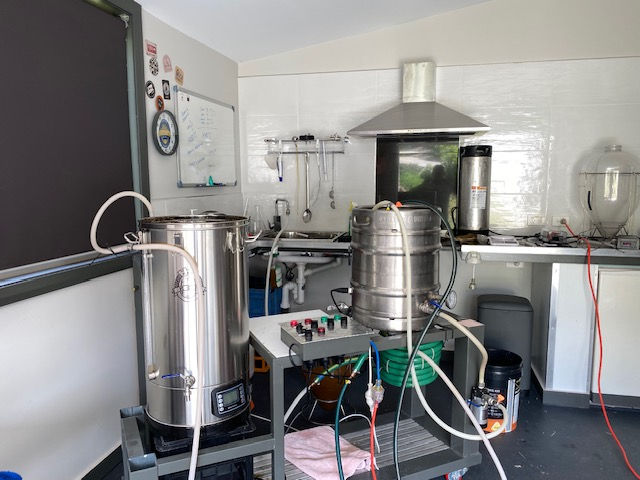My Brew Day for a Pale ale or Ipa.
- Andrew Pearse
- Mar 10
- 4 min read
7am. Flick on the power to start warming the water in both the mash tun and the Hot liquor tank for the sparge water. While the water is heating, I weigh out and crush the grain ready for the Mash. Lucky for me, I have a whole storage room of grain to choose from.

When the Mash water has reached the desired temperature, usually about 70 degrees, its time to mash in. My mash tun, is also my brew kettle, its a 70 litre Guten. Similar to all the new single vessel stainless brew house units available with an electric heater, a timer panel and malt pipe and pump.

Using a mash paddle I stir in the grains slowly so they don’t clump and are all nice and wet.
I usually recirc the water and stir the grain a few times during the mash and have time to prepare the heated sparge water. The water is just straight from the tap, the local supply is pretty good but I usually treat it all with Metabisulphite ( campden tablet ) the night before to ensure all chlorine and chloramines are evaporated out over night.
Any salt or acid additions are also done, depending on what profile water I decide to use.
Once the mash is done, usually an hour at 67 Degrees, I’ll have enough sparge water heated to wash the grains whilst pulling the malt tube out of the Guten.
The beauty of having one vessel brewing is that I can start the heat to boil stage while I’m sparging to save a little time. In fact I can start heating at mash out to save a bit more time.
My malt pipe half full of spent grain is dumped in the garden and quite often attracts a few local wallabies for a feed.

Getting close to 10 am at this point and I keep an eye on the boil pot while I prepare the additions which include bittering hops, aroma hops, whirlfloc tablet and whirlpool hops. I also at this stage take my yeast out of the yeast fridge and let it come up to room temperature.
Sometimes I remove the protein froth at the top of the boil and sometimes not. I don’t really think it make a difference.
A timer on my phone interrupts my music playlist and alerts me to the hop additions and I have plenty of time to prepare and sanitize the fermenter and the counterflow chiller, and hookup and sanitise hoses ready for the transfer. My fermenter is a plastic conical suitable for pressure fermenting.
The Guten has an inbuilt pump ideal for producing a whirlpool but I just stir with a long spoon. The wort is boiling and dangerous and care should be taken stirring at this time, ask me how I know....
When I reach about 80 degrees I’ll throw in the “whirlpool hop addition” and let it rest for 10 minutes or so.
Transfer through the counterflow chiller straight to the sanitized fermentation vessel using just tap water to cool the wort to about 20degrees. The waste water from the counterflow chiller takes 60 degrees of temperature from the wort and is now hot and I fill as many buckets as I can to use this to clean up.
Fermenter full, boiler empty ‘cept for a nice cone of hops and proteins. Temp good so yeast in.
I only use dry yeasts these days as its really good quality, there’s plenty of variety and quite cheap. Trying to find liquid yeasts that are in date is a problem where I live. Dry yeast is best kept at fridge temps and sprinkled on close to ferment temps to avoid temperature shock.
I’ll put a spunding valve on in an open position and a blow off tube to some sanitizer for the first few days and usually pressure ferment to about 10 psi for the balance of the 10 days ferment time. I’ll dry hop sometime depending on the style between high krausen and cold crash. Always wait at least 7 to 10 days for fermentation, don’t bother checking the Final gravity till I’m ready to keg as they’re always close to predicted. Occasionally I’ll even forget to check the final gravity, especially if I’ve decided to test a few brews towards the end of brew day.

My dry hop method is nothing fancy, I believe it’s a waste of effort suspending hops in a bag inside the vessel with a magnet or drop string as they just lose their aroma and oils in the c02 blow of for days waiting to drop. Just remove the lid gently don’t disturb the c02 layer drop the fresh hops in straight from the freezer and top up with a little c02 if you think you need it. I usually dry hop before the end of ferment anyway so any oxygen that enters via the hop pellet is quickly used up by the yeast. It’s been a long time since I’ve had an oxidized beer.
Clean up of the brewery takes half an hour or so and I’m done by 12 o’clock. In 2 weeks I’ll have a keg or two of something great and at around $2 or so a schooner ( depending on the hop rate).
I don’t brew to save money but to have the beers that I want to drink on tap at home.
Brew Love. Andrew.




Comments